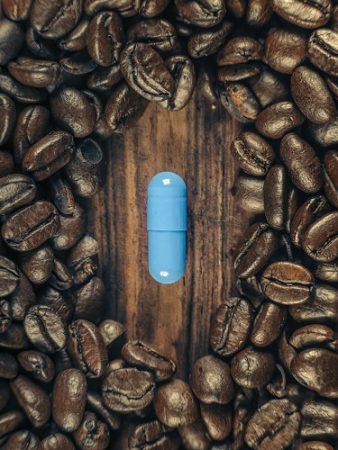Stephen A. Cherniske is a renowned health educator. With a bachelor’s degree from the State University of New York at Albany and a master’s degree in nutrition from Columbia Pacific University, Mr. Cherniske has over 30 years of clinical, research, and teaching experience. His latest book, Caffeine Blues, is a must reading for allhealthseekers.
Caffeine Blues is not a bad-news bookThe terrible news is what happens if you DON’T read it. Caffeine is an addictive drug that contributes to a long list of diseases. The book provides the information you need to avoid those health problems, such asanxiety,insomnia, panic attacks, cardiovascular disease, diabetes, eye and vision problems, gastrointestinal disease, miscarriage, etc.
The Caffeine Cover-up
The caffeine industry does not provide this critical information. They’re working overtime to make sure you DON’T learn about caffeine’s proven harmful effects.
Informed Choice To Avoid Caffeine
I’m not saying that everyone should stop drinking coffee,tea, and soft drinks. Instead, I believe that people should make informed choices, and until this book was published, that was impossible to do. The book provides an easy quiz to enable the reader to determine, first of all, how much caffeine they are consuming in a day. Usually, people are shocked. Next, the book provides a straightforward way to evaluate how that quantity of caffeine may be harming you. And third, the book provides an easy and painless program for reducing or eliminating your caffeine intake.
Caffeine Does Not Give You Energy
This is the greatest myth that the caffeine industry has perpetuated. Scientifically, you cannot measure any increase in energy provided by caffeine. You can measure higher stress levels, as evidenced by spikes in stress hormones, elevations in blood pressure and heart rate, but no one would claim that these are positive benefits.
There Are Ways to Increase Your Body’s Production of Energy
This has been my particular area of research for 20 years (including years on the American College of Sports Medicine faculty and advisor to the U.S. Olympic Team). Caffeine Blues includes this breakthrough material so that readers can begin to experience greater levels of health, energy, and vitality at any age and in any condition.
Caffeine DOES NOT improve learning or memory
The exact opposite is true. I have scientific studies showing that caffeine, as commonly consumed, can reduce cerebral flow by as much as 30%. That means less oxygen to the brain and reduced memory and cognition.
Caffeine DOES NOT give you a liftCaffeine is referred to as a mood elevator, but this is inaccurate. If you take a person who doesn’t drink caffeine and give them some, it doesn’t elevate their mood. It makes them uncomfortable and tense. Caffeine appears to elevate mood in chronic users, but research clearly illustrates that it’s simply enabling them to avoid the depression and fatigue associated with withdrawal. It’s a classic addiction scenario.
If you deprive a smoker of their cigarettes, they feel miserable. You give them a cigarette; they feel much better. Does that mean cigarettes give you a lift or are somehow good for you?
Women’s Health
Caffeine is far more damaging to women, and Caffeine Blues contains an entire chapter devoted to women’s health issues. It Highlights the effects of caffeine on bone mass and fracture risk, heart disease, anxiety and panic attack, menopause, PMS, anemia, fibromyalgia, chronic fatigue, depression, fertility and conception disorders, and pregnancy complications childbirth.
Children’s Health
Increasingly, children are becoming the primary target market for the caffeine industry. The strategy? Addict them at an early age to gain life-long customs. Caffeine Blues uncovers the darker side of this industry, as it markets products with ever-increasing amounts of caffeine in ever-increasing serving sizes. It explains how soft-drink companies ignored congress, health departments, and medical associations and went directly for the promised land of market share: the schools.
Today, in direct defiance of USDA guidelines, soft drink machines line the halls, cafeterias, and walkways of schools from coast to coast. It is a matter of great urgency, and the health and welfare of an entire generation are at stake.
Ecology: pesticides, rain forest destruction, and land use issues
Coffee is the largest agricultural commodity in the world. More coffee is grown and traded than wheat, rice, corn, or livestock. More than fruit, vegetables, or any staple of the diet, COFFEE is number one. It’s the third leading commodity after petroleum and strategic metals. More than automobiles, steel, and technology. Add all of those together, and it couldn’t touch coffee. Why? Because coffee is addictive.
There’s Another Problem
Coffee is also the most heavily sprayed of all agricultural commodities. It is grown in regions with very few restrictions, regulations, or protections regarding pesticide use. The environmental impact is tremendous. Coffee doesn’t grow in Kansas, and it grows in and around the rainforest. The rain forest has been destroyed to plant coffee farms.
The fact is that coffee is a terribly inefficient and incredibly labor-intensive crop. Coffee is the seed of a cherry from a tree. Coffee cherries ripen at different times, so they have to be picked by hand. It takes approximately 2,000 Arabica cherries to produce just one pound of roasted coffee. Since each cherry contains two beans, your one pound of coffee is derived from 4,000 coffee beans. The average coffee tree only produces one to two pounds of mastered coffee per year and takes four to five years to produce its first crop.
Do the math. The world demand is 6 billion kg per year. That’s 13 billion pounds. If the average tree produces one to two pounds of roasted coffee per year, this 13 billion pounds of coffee requires at least 7 billion coffee trees. The average farmer gets about 100 trees per acre, which means that 70 million acres of the most fertile land on this planet is devoted entirely to growing a product with no nutritional value; one that has proven and significant anti-nutrient properties, that is addictive, and that contributes to a long list of disease states.
Follow us: Facebook,Twitter,Instagram,Pinterest






